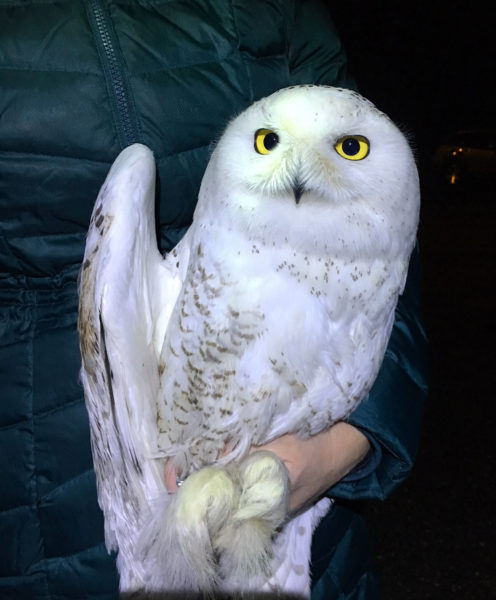
Hereford, the day he was banded and tagged near Stone Harbor, NJ. (©Mike Lanzone)
While this has been an exciting winter in many ways, it’s been a rough one in another — for the third time this season, we’ve lost an owl, and in a depressingly familiar place.
Hereford, whom we tagged Feb. 12 on the New Jersey coast near Stone Harbor, was recovered dead this week after we noted that his signal had become stationary around Feb. 26-27, in the tidal marshes very close to where Higbee had been struck and killed by a vehicle in early January. It wasn’t until the March 1 transmission that we realized there was a problem, however, and getting to him was going to be tricky. We’d need a boat to reach Hereford’s location, but worse, there was a huge, approaching nor’easter with forecasts for dangerous winds and unusually high tides. We would have to delay the recovery operation until after the storm, and hope the waves and winds wouldn’t wash him out to sea.
Fortunately, he hadn’t been moved too much by March 5, which is when conditions finally allowed Bob Fogg and Mike Lanzone from CTT to head out to try to find him. Bob was in a full wetsuit, and worked his across the channel on a stand-up paddleboard — not the usual midwinter boat excursion, but the winds had finally died and Mike was his safety spotter. Bob quickly found Hereford and brought him back.
At this point, all we can do is a make some educated guesses about what did and did not happen. One possibility might have been eagle predation — in fact, while Mike was watching Bob he saw a bald eagle chasing (unsuccessfully) a different snowy. There were no obvious signs of predation on Hereford, but an injury that later proved fatal might not show. There’s also the very real chance he was hit by a vehicle on the same busy road where Higbee was killed just a few hundred yards from where he was found — perhaps able to fly across the channel but succumbing later to, say, a head injury, which is all too common with raptors along roads.
Hopefully, we’ll know more soon. Our veterinary team will be conducting a necropsy next week, and we’re hoping they can make a firm determination — although the length of time between death and recovery will make that more of a challenge.
We knew that tagging another of the several snowies hunting that area this winter was a risk, but it was one that we — and our partners at the New Jersey chapter of the Nature Conservancy, which underwrote both Higbee’s and Hereford’s transmitters — thought was worth taking. Understanding the winter ecology of these birds means also understanding the risks, and each time we lose an owl we gain another sad insight into that facet of their ecology.
There’s a lot of great news this week, too, so watch for the next post with an update on some of the exciting movements we’re seeing, including a remarkable over-water crossing. (And the temporary hiccup with the maps has been solved, so feel free to see where the other birds have been heading.)


4 Comments on “Gone Too Soon”
Could tagging them possibly be contributing to their deaths? Perhaps the transmitters interfere with their natural navigation systems. This is not a criticism or a snarky comment. I am asking out of real concern.
Thanks for a great question, Nanci — it’s exactly the kind of question researchers ask themselves all the time. In this case, we have pretty strong evidence that transmitters aren’t a problem, because our colleagues at Laval University in Quebec did a rigorous study on snowy owls in the Arctic, comparing owls with bands and transmitters, versus owls with just leg bands. They found no difference in the survival and mortality rates between the two groups, and a small but significant *increase* in productivity rates (how many chicks they raised) among tagged birds.
The kind of GPS transmitters we’re using have also been used for many years on a variety of long- and moderate-distance migrant birds, and the tagged individuals haven’t shown any unusual tendency to go in strange directions, which would indicate navigational problems. In fact, the issues we’ve seen with tagged owls have been from threats — like vehicle and plane collisions, electrocution, collisions with high-tension wires and drowning during nor’easter storms — that also claim hundreds of untagged owls every winter. We’re confident the mortality we see among our tagged birds simply documents the same dangers all snowy owls face when they come south.
Again, thanks for a terrific question.
I watched a large snowy owl fly over my car on River Rd in PA. The owl was headed over the Delaware Canal toward the Delaware River. I had never seen one, so it was so beautiful to see!
We had 4 or even 5 snowy owls at Jones Beach Long Island this year …Thankfully for the owls it is a hike to get to them and road traffic isn’t an issue…It was an amazing year and feel so blessed to have seen them a few times
Going to miss them